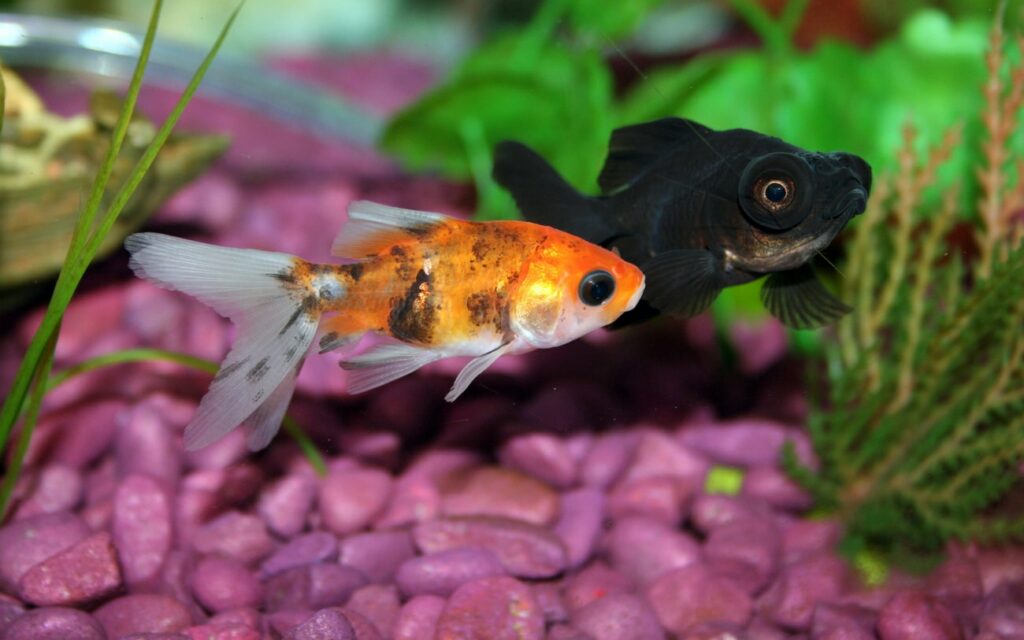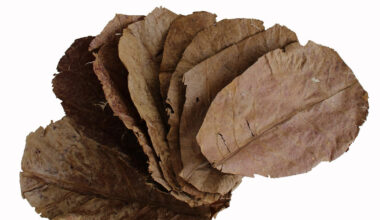A goldfish turning black can be a very worrying sight. The once bright colors being covered with dark spots simply doesn’t look normal.
But it’s important to investigate before you panic.
You see, there are a few different causes for this. And not all of them are bad.
This guide will explain why goldfish turn black, if it’s something to worry about, and what you can do to help them (if needed of course).
Table of Contents
Is This Something To Be Concerned About?
Goldfish are the quintessential “easy” fish to take care of. They’re readily available at most pet stores and they adapt well to life in your aquarium.
The most iconic feature of the goldfish is its shimmering gold color. This vibrant appearance is a product of thousands of years of selective breeding.
When a pristine goldfish suddenly starts to turn black, it’s easy to assume that something is going wrong. Color changes to white are far more common than changes to black. So when your fish starts to darken up, it’s important to take the issue seriously!
Black color changes could be a sign that your fish is suffering internally. They could be experiencing a health issue that you need to address if you want your goldfish to continue living.
That said, not all instances of a black color change are life-threatening or even dangerous. Sometimes, color changes are completely natural for the fish.
So how do you determine if your fish turning black is a cause for concern?
You have to understand what is causing this change. You must learn to identify potentially serious symptoms and be proactive about providing care when it’s needed.
Common Causes
There are a handful of reasons why a goldfish might begin turning black.
As we mentioned earlier, black color changes are pretty rare among all types of goldfish. Thus, you’ll need to consider all possible causes to determine the best course of action.
Black is actually a notoriously unstable color in goldfish. Many pure black goldfish end up losing the color and turning white or yellow. Watching a healthy goldfish darken up is incredibly rare.
As a result, most assume that there’s a serious health issue to blame. That may be the case, but there are still some relatively innocent causes, too.
Here are some of the most common causes of a black color change and what you can do to provide some care for your goldfish.
1. Ammonia In The Tank
Ammonia changes are, by far, the most common reason why goldfish turn black.
Generally, the color change starts on the fins. Over time, it can get progressively worse and spread to the body. There, it’ll appear as small batches of black skin that look burnt.
Author Note: This isn’t an issue that’s reserved for goldfish only. Any light-colored fish species can experience it.
Ammonia is a toxic chemical that’s produced inside your fish aquarium. Most don’t realize it, but caring for fish in captivity is a constant battle of preventing ammonia buildup in the tank!
That’s the whole point of the filtration and cycling system!
Fish produce ammonia through waste. Decaying plant matter and uneaten food can cause ammonia spikes too. Usually, aquarists can keep ammonia levels very low by simply cleaning the tank on a routine schedule.
Water changes are very effective in getting rid of the chemical. A powerful filtration system will help as well. When the tank isn’t clean, ammonia levels can rise very fast.
This chemical has the potential to kill fish. To make matters worse, the tank doesn’t need a lot of it to be fatal. Even a small concentration of 2 parts per million is enough to kill small fish like the goldfish. Ideally, your ammonia levels should be 0 PPM.

So how does ammonia cause a black color change?
Well, the chemical is essentially burning your goldfish’s skin. That’s how ammonia kills the fish. Higher concentrations burn the gills.
The good news is that seeing your goldfish turn black could actually be a sign that your fish is on the mend.
You see, it’s impossible to see ammonia in the water. You can’t see when the chemical is burning your fish’s body either. The black patches on your goldfish mean that the body is healing.
This could indicate that levels have dropped back to a safer level. But, don’t assume anything! Take out your test kit and check the water. Anything above 0 PPM should be a cause for concern.
Author Note: To help your fish, do more frequent water changes. Change roughly 20 percent of the water every week. Then, check on your filtration system and make sure that it’s performing efficiently.
Next, you’ll want to take a look at all of the fish in your tank. You might see odd swimming patterns or labored breathing. Those are telltale signs of ammonia poisoning. If you have a diseased fish, move them to a quarantine tank.
Sick and stressed fish offload a lot of ammonia. Unfortunately, high levels of the chemical only exacerbate the problem.
Check the water conditions and remove any dead plants or leftover food. You might want to consider changing how you feed the fish, too.
As a good rule of thumb, only provide enough food that your fish can eat in a couple of minutes (this can vary a bit depending on the species of course). After that, remove any excess to ensure that ammonia levels don’t spike again.
2. Genetics
Now onto a more innocent cause. Some specimens of goldfish are genetically predisposed to color changes. While a goldfish turning black is rare, it’s still possible!
“Mixed breed” goldfish are the most likely to go through some changes in their life. These are usually the cheaper goldfish you see at the market. They may already have some strange coloration patterns on them.
These fish sometimes change colors when they transition from the juvenile stage to the adult stage. This occurs within the first year or two. The change is slow, so you might not even notice it at first.
The goldfish may develop darker black patches on the body. This could be accompanied by some areas getting lighter too.
Author Note: Some goldfish even go through major changes where their body becomes a more vivid color of orange or yellow!
“Purebred” goldfish that come from a reputable breeder can turn a bit black as well. Though, the change is usually a lot more subtle. You might see some black streaks develop on the fins or small dots of dark color.
Whatever the case may be, a goldfish turning black as the result of genetics is nothing to worry about. It’s completely normal and doesn’t lead to any health issues or a shortened lifespan.
3. Disease
Goldfish turning black due to disease is rare, but it’s still a possibility worth mentioning. The disease in question is called black spot disease.
This is far more common in goldfish kept in ponds than those living in enclosed aquariums. The disease can also plague fish in the wild. Many fishermen encounter diseased fish with this ailment all of the time.
So, what is black spot disease? It’s a parasitic fluke disease. Fish catch it from infected water snails. Goldfish in ponds can also encounter the disease if bird droppings make their way into the water.
When fish have black spot disease, they will develop literal spots on the body. Infestations can vary quite a bit as well. In mild cases, you might see a couple of spots here or there.
However, serious infestations can significantly cover the goldfish in black.
Author Note: These black spots are actually parasite eggs that burrow into the skin. Once they’re in the fish, the eggs will develop into hard black cyst for protection. Eventually, the spots will burst as the parasite is released (ew).
If you suspect that disease is to blame, take a look at your goldfish’s behavior. The spots tend to be itchy, so fish will flick their bodies and try to rub against items to get relief.
To treat this disease, you must remove snails from the environment. This can break the parasite’s life cycle. It takes time, but fish will recover.
While the disease sounds awful, it’s considered to be less dangerous than ich.
Again, black spot disease is rare. Unless you’re keeping your goldfish as outdoor pond fish, your chances of encountering it are very low.
Can They Turn Back To Their Original Color?
Goldfish turning black may or may not retain their natural color. It all depends on the cause of this change and the prognosis.
If the black color change is genetic, your fish will stay that way for the rest of its life! While the change may not be what you planned for, it’s not something that will affect the health of your fish or its quality of life in any way.
If your goldfish turned black because of ammonia poisoning, the biggest concern is going to be whether or not your fish makes it. The prognosis for serious ammonia poisoning is not good. In many cases, it’s a fatal issue.
However, don’t assume that your fish is going to die if ammonia has spiked in the tank.
Remember, the black spots are a result of the healing of the chemical burns. Monitor your fish’s behavior closely. If they are swimming normally and being perky, the goldfish could make a full recovery!
In this case, the spots will gradually fade away. It takes time, but your goldfish will eventually go back to its normal color. Just make sure that you take the steps to address ammonia issues so that future burns don’t occur.
Now You Have The Proper Knowledge
Now you have the knowledge to figure out why your goldfish is turning black, and if there’s anything you need to do differently.
Seeing these beautiful fish darken over time can be sad at first. But many times it’s just a natural occurrence.
Assuming they’re healthy, learn to appreciate this interesting change in color. It’s all part of the fun!

